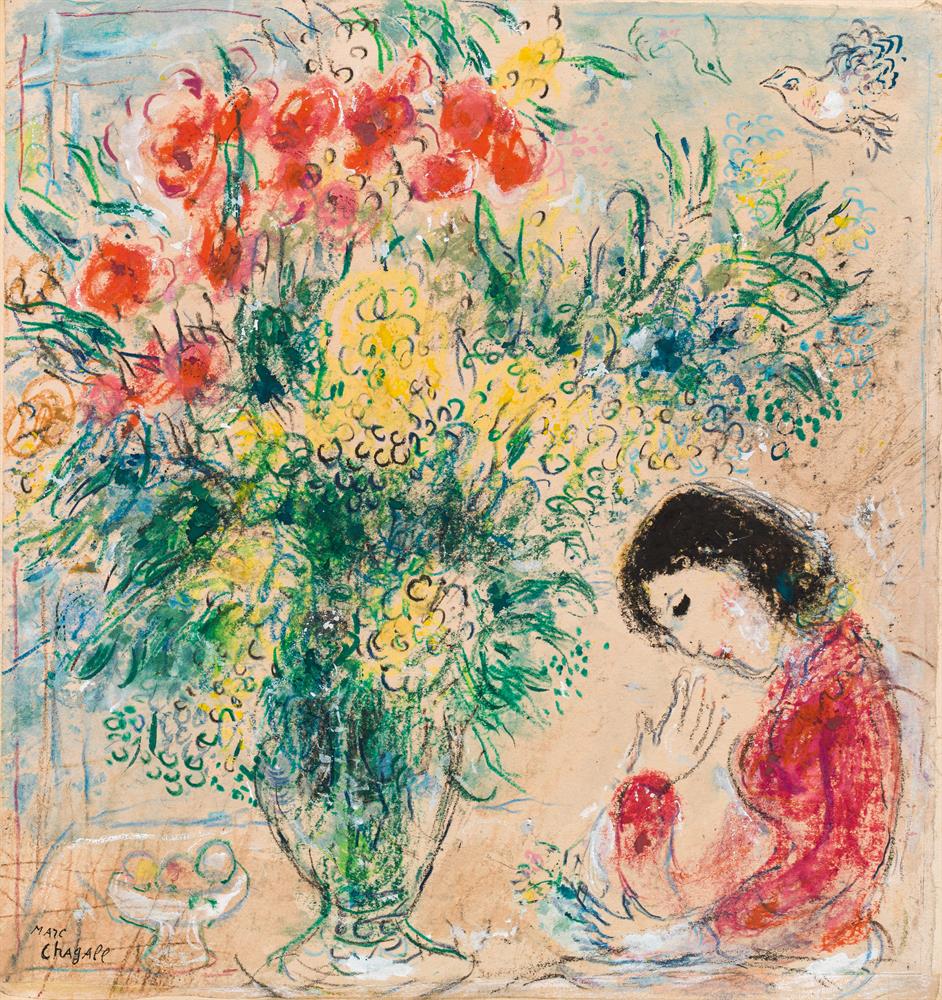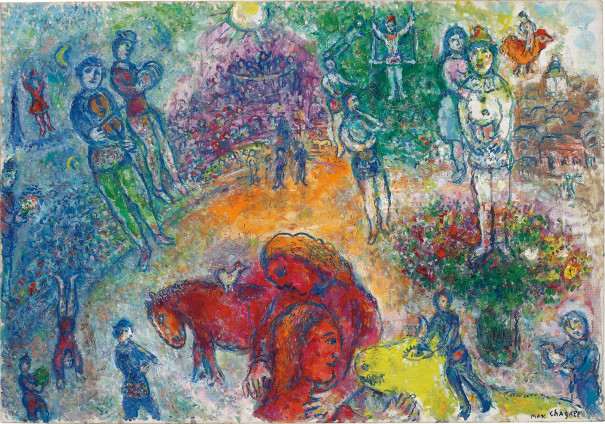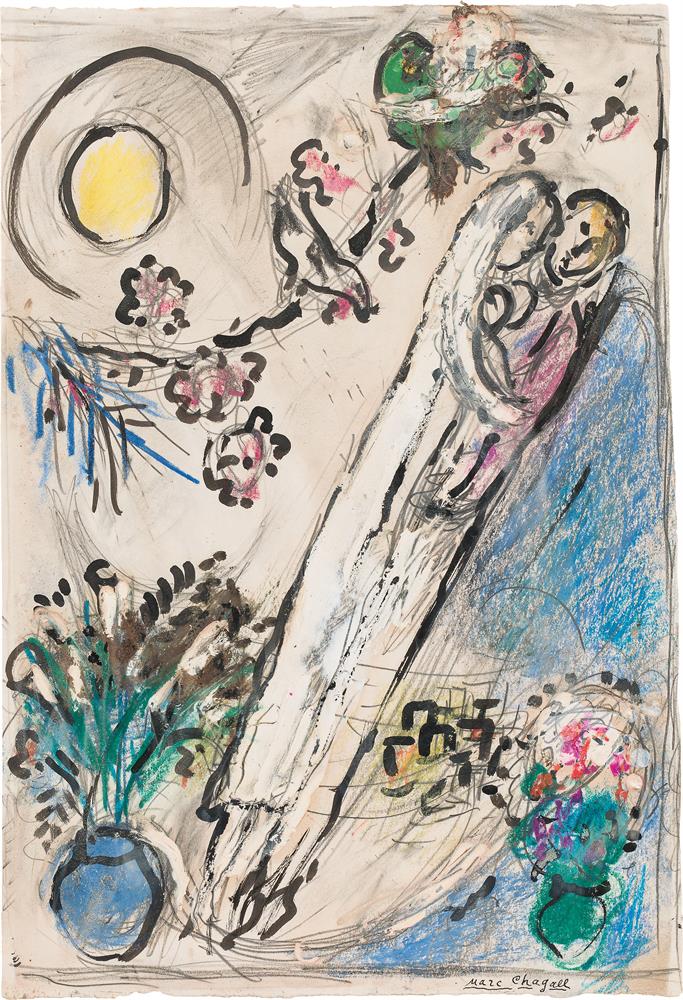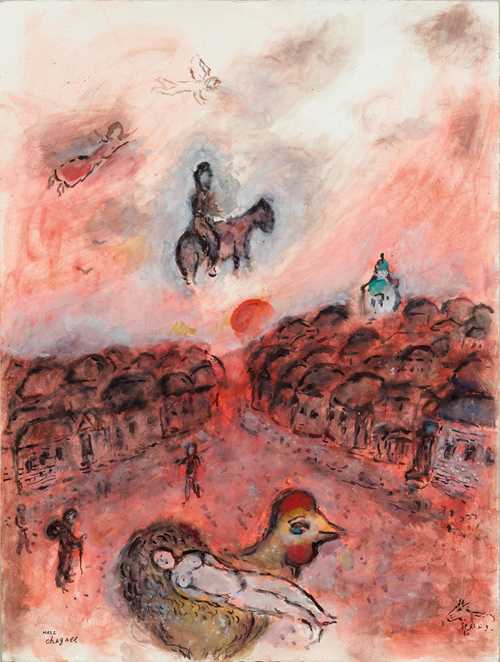PROPERTY FROM A PRIVATE COLLECTION, SWEDEN MARC CHAGALL (1887-1985) Le bonheur du jeune couple aux fleurs signed 'Marc Chagall' (lower left) gouache, India ink and pencil on paper 20 x 13 in (51 x 33 cm) Executed in 1967 Fußnoten The authenticity of this work has been confirmed by the Comité Chagall. Provenance Heinz Berggruen & Cie, Paris (acquired from the artist by October 1968). Hokin Gallery, Inc., Chicago (acquired from the above by 1976). Private collection, California (acquired from the above in 1976). Gustfield-Glimer Galleries, Lt., Illinois. Private collection, United States. Mollbrink's Art Gallery, Sweden (acquired in November 2014). Acquired from the above. Le bonheur du jeune couple aux fleurs is emblematic of Chagall's dreamlike vision and replete with the artist's tender iconography—the town under moonlight, a blue rooster, an abundant floral bouquet and a couple, all floating together in a dreamlike scene, together embodying the artist's vision of romantic love and virality. "In it lies the true Art: from it comes my technique, my religion," Chagall explained. "All other things are a sheer waste of energy, waste of means, waste of life, of time... Art, without Love—whether we are ashamed or not to use that well-known word—such a plastic art would open the wrong door" (quoted in J. Baal-Teshuva, (ed.), Chagall: A Retrospective, Westport, 1995, p. 179). The female figure in the present work is a pastiche of Chagall's lovers: his greatest love and first wife, Bella; Virginia Haggard McNeil, a young woman who saved Chagall from the depths of sorrow after Bella's early demise in September 1944; and Valentina "Vava" Brodsky, his final wife and dealer. Chagall met his muse Bella Rosenfeld in 1909, and Chagall continued to depict his devotion to her and the tenderness of their relationship well after her death. Reflecting upon meeting Bella, Chagall explained: "Her silence is mine. Her eyes, mine. I feel she has known me always, my childhood, my present life, my future; as if she were watching over me, divining my innermost being, though this is the first time I have seen her. I know this is she, my wife. Her pale coloring, her eyes. How big and round and black they are! They are my eyes, my soul" (quoted in J. Baal-Teshuva, (ed.), Chagall, A Retrospective, New York, 1995, pp. 58-59). The couple in flight became a trope as one of the artist's primary pictorial configurations that he established during the 1920s. In the present work, the couple is seen flying over his home city of Vitebsk. The fusion of the figures in the present work underscores the couple's unity, but the woman's position as an inversion to Chagall's own indicates a disconnection; no longer are the figures intertwined and embracing, floating above the pull of gravity together, but rather while connected, they are distinctly apart. Lionello Venturi wrote about depictions of Chagall flying, stating "if he paints himself and his Bella in the sky, then everything takes on the bright colors of spring...the movement of the two figures in the air has a fine rhythm [...]. Chagall's conception of movement is highly personal" (L. Venturi, Marc Chagall New York, 1945, p. 32). However, in the present work, Chagall has inverted his female figure's position and combined his three lovers' physiognomies. Bella died of sepsis on September 2, 1944, after which Chagall later reflected, "the thunder rolled, the clouds opened...Everything went dark" (quoted in J. Wullschlager, Chagall: Love and Exile, United Kingdom, 2008, p. 416). For six months Chagall stopped painting and nightly would howl for his own death. His daughter with Bella, Ida, sought to distract her father by hiring a housekeeper, Virginia, to keep Chagall company. The young, unhappily married woman soon became Chagall's lover and brought him out of his severe depression, after which the artist resumed painting. The artist and Virginia separated in 1952, and fearing that her father was alone again, Ida i
PROPERTY FROM A PRIVATE COLLECTION, SWEDEN MARC CHAGALL (1887-1985) Le bonheur du jeune couple aux fleurs signed 'Marc Chagall' (lower left) gouache, India ink and pencil on paper 20 x 13 in (51 x 33 cm) Executed in 1967 Fußnoten The authenticity of this work has been confirmed by the Comité Chagall. Provenance Heinz Berggruen & Cie, Paris (acquired from the artist by October 1968). Hokin Gallery, Inc., Chicago (acquired from the above by 1976). Private collection, California (acquired from the above in 1976). Gustfield-Glimer Galleries, Lt., Illinois. Private collection, United States. Mollbrink's Art Gallery, Sweden (acquired in November 2014). Acquired from the above. Le bonheur du jeune couple aux fleurs is emblematic of Chagall's dreamlike vision and replete with the artist's tender iconography—the town under moonlight, a blue rooster, an abundant floral bouquet and a couple, all floating together in a dreamlike scene, together embodying the artist's vision of romantic love and virality. "In it lies the true Art: from it comes my technique, my religion," Chagall explained. "All other things are a sheer waste of energy, waste of means, waste of life, of time... Art, without Love—whether we are ashamed or not to use that well-known word—such a plastic art would open the wrong door" (quoted in J. Baal-Teshuva, (ed.), Chagall: A Retrospective, Westport, 1995, p. 179). The female figure in the present work is a pastiche of Chagall's lovers: his greatest love and first wife, Bella; Virginia Haggard McNeil, a young woman who saved Chagall from the depths of sorrow after Bella's early demise in September 1944; and Valentina "Vava" Brodsky, his final wife and dealer. Chagall met his muse Bella Rosenfeld in 1909, and Chagall continued to depict his devotion to her and the tenderness of their relationship well after her death. Reflecting upon meeting Bella, Chagall explained: "Her silence is mine. Her eyes, mine. I feel she has known me always, my childhood, my present life, my future; as if she were watching over me, divining my innermost being, though this is the first time I have seen her. I know this is she, my wife. Her pale coloring, her eyes. How big and round and black they are! They are my eyes, my soul" (quoted in J. Baal-Teshuva, (ed.), Chagall, A Retrospective, New York, 1995, pp. 58-59). The couple in flight became a trope as one of the artist's primary pictorial configurations that he established during the 1920s. In the present work, the couple is seen flying over his home city of Vitebsk. The fusion of the figures in the present work underscores the couple's unity, but the woman's position as an inversion to Chagall's own indicates a disconnection; no longer are the figures intertwined and embracing, floating above the pull of gravity together, but rather while connected, they are distinctly apart. Lionello Venturi wrote about depictions of Chagall flying, stating "if he paints himself and his Bella in the sky, then everything takes on the bright colors of spring...the movement of the two figures in the air has a fine rhythm [...]. Chagall's conception of movement is highly personal" (L. Venturi, Marc Chagall New York, 1945, p. 32). However, in the present work, Chagall has inverted his female figure's position and combined his three lovers' physiognomies. Bella died of sepsis on September 2, 1944, after which Chagall later reflected, "the thunder rolled, the clouds opened...Everything went dark" (quoted in J. Wullschlager, Chagall: Love and Exile, United Kingdom, 2008, p. 416). For six months Chagall stopped painting and nightly would howl for his own death. His daughter with Bella, Ida, sought to distract her father by hiring a housekeeper, Virginia, to keep Chagall company. The young, unhappily married woman soon became Chagall's lover and brought him out of his severe depression, after which the artist resumed painting. The artist and Virginia separated in 1952, and fearing that her father was alone again, Ida i
.jpg)
.jpg)
.jpg)
.jpg)
.jpg)









Testen Sie LotSearch und seine Premium-Features 7 Tage - ohne Kosten!
Lassen Sie sich automatisch über neue Objekte in kommenden Auktionen benachrichtigen.
Suchauftrag anlegen